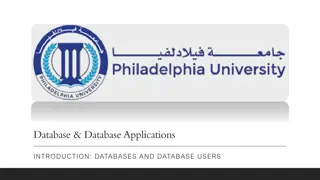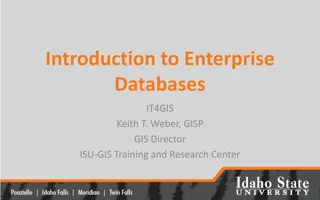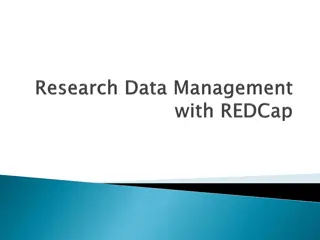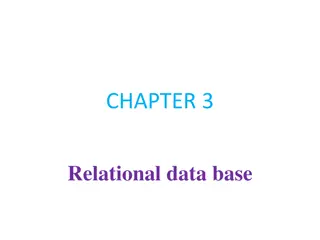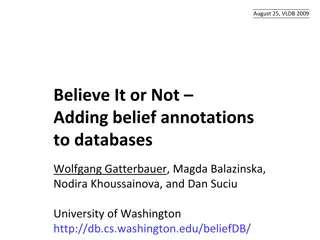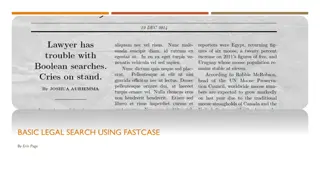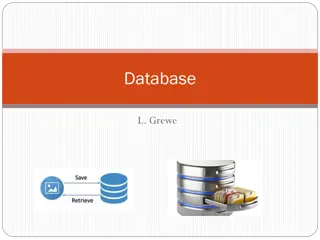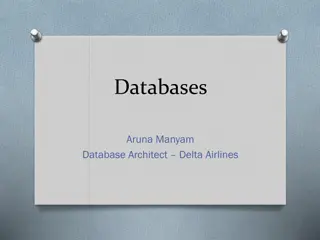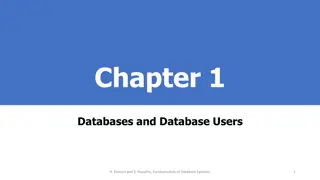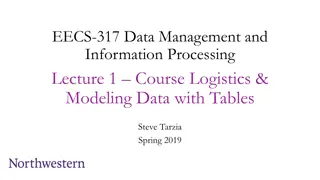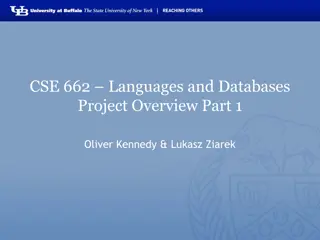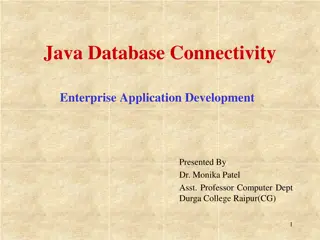Understanding Data Management and Databases
Explore the concepts of data, information, and knowledge, learn why databases are superior to spreadsheets for data storage, and delve into the organization and functionality of relational databases for decision-making purposes.
Download Presentation

Please find below an Image/Link to download the presentation.
The content on the website is provided AS IS for your information and personal use only. It may not be sold, licensed, or shared on other websites without obtaining consent from the author. Download presentation by click this link. If you encounter any issues during the download, it is possible that the publisher has removed the file from their server.
E N D
Presentation Transcript
Acknowledgements Professor Ruth A. Guthrie at California Polytechnic University, Pomona, has granted a permission for this instructor to use and/or modify the PPT for her CIS310 http://www.cpp.edu/~raguthrie/CIS310/ for this MIS 315 online class.
Chapter 4 Data and Databases
Learning Objectives Upon successful completion of this chapter, you will be able to: Describe the differences between data, information, and technology Define the term database and identify the steps to creating one Describe the role of a database management system Describe the characteristics of a data warehouse Define data mining and describe its role in an organization
Data, Information, and Knowledge Knowledge Wisdom Data Information Data are raw facts Quantitative numeric Qualitative descriptive Alone is not useful Information is processed data for a given context and specific application Knowledge is human perception of the real world
Databases Why databases, not spreadsheets, for storing data? common defects in data resources management by using spreadsheets to store data: Spreadsheets have no control of data redundancy Spreadsheets do not enforce data integrity Spreadsheets rely on human memory for search Databases control data redundancy, maintain data integrity, and organize data.
Databases (contd) Organized collection of related information to generate knowledge for decision making purposes For example, a university transcript database may contain information on students, classes taken, and grades received A separate university database would be created to maintain your financial information Relational databases (such as Microsoft Access) where data in organized into one or more tables Tables are a collection of fields E.g., Student ID, Course ID, Grade Earned Record is an instance in the table E.g., your specific information in the table
Databases continued Rows and columns in a table
Database Design Design is a critical first step in creating a database Understand the goal of how the database will be used Identify the data needed as part of accomplishing this goal Identify how the data is related to each other Identify tables and fields to organize the data Each table needs a primary key of which field(s) is unique to each record and will not change For example, our Bronco ID Normalization is performed to eliminate data redundancy
Database Design (contd) Each field in the database has a data type to store information: Text non-numeric data less than 256 characters Number numeric data Yes/No stores 0 for No or False and 1 for Yes or True Date/Time number data type that can be interpreted as a number or a time Currency monetary data Paragraph Text stores text longer than 256 characters Object data that can t be typed such as a picture or music file Data types dictate what functions can be performed on the data For example, 2 number fields can be used to perform calculations Data types indicate the amount of storage needed for each field
Database Design (contd) Entity-Relationship (ER) diagrams are used for database design The design viewed within the database
Database Reports Structured Query Language (SQL) is a tool/language that helps extract information from the database for analysis purposes QBE (Query by Example) is a graphical query tool, to retrieve data though visualized commands QBE generates SQL for you, and is easy to use In comparison with SQL, QBE has limited functionalities and is unable to work without the DBMS environment
Other Database Types Hierarchical - parent/child relationship between data Business Classes Computer Information Systems Accounting Finance ACC207 ACC208 CIS101 CIS310 FRL300 FRL 301 Document-centric places data into documents that can be manipulated NoSQL (Not only SQL) for unstructured data
Database Management Systems Database Management Systems (DBMS) is an application that create and manage the databases Oracle, DB2, SQL Server, MySQL Microsoft Access is end-user oriented DBMS for small scale databases and is easy to use Enterprise Databases serve the entire organization
Data Warehouse Consists of extracts from one or more of the organization s databases Allows the data to be copied and stored for analysis Needs to be refreshed as the data changes Data is time-stamped when extracted Allows comparisons between different time periods Data is standardized All similar fields (e.g., calendar dates) are structured the same Date is MM/DD/YYYY Data marts are smaller subsets of data warehouses for specific business problems
Data Warehouse Benefits Forces organizations to better understand the data Centralized view of data to identify inconsistent data Once inconsistencies are resolved, higher quality data is used to make better business decisions Data can be analyzed over multiple time periods Tools are available to combine data and gain more insight into business operations
Data Mining Automated process of analyzing data To find previously unknown trends, patterns, and associations To make better business decisions Starts with a hypothetical result in mind Privacy concerns Easier to combine disparate sources of information and when aggregated tell you much more about the individual Data brokers now to sell this information Business intelligence collecting and analyzing information to increase their competitive advantage Business analytics uses internal company data to improve business processes and practices
Knowledge Management (KM) Companies and individuals accumulate knowledge Not consistently written down or saved If recorded, not consistently organized KM is the process of formalizing the capture, indexing, and storing of knowledge
Summary Described the differences between data, information, and technology Defined the term database and identify the steps to creating one Described the role of a database management system Described the characteristics of a data warehouse Defined data mining and describe its role in an organization


